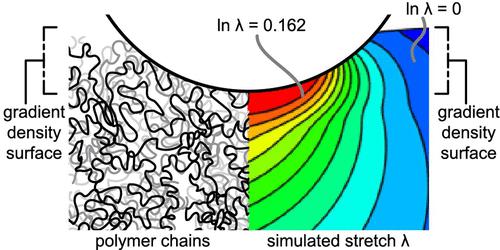Our official English website, www.x-mol.net, welcomes your
feedback! (Note: you will need to create a separate account there.)
Soft Contact Mechanics with Gradient-Stiffness Surfaces
Langmuir ( IF 3.7 ) Pub Date : 2022-07-27 , DOI: 10.1021/acs.langmuir.2c00296 Md Mahmudul Hasan 1 , Christopher L Johnson 1 , Alison C Dunn 1
Langmuir ( IF 3.7 ) Pub Date : 2022-07-27 , DOI: 10.1021/acs.langmuir.2c00296 Md Mahmudul Hasan 1 , Christopher L Johnson 1 , Alison C Dunn 1
Affiliation

|
The stiffness in the top surface of many biological entities like cornea or articular cartilage, as well as chemically cross-linked synthetic hydrogels, can be significantly lower or more compliant than the bulk. When such a heterogeneous surface comes into contact, the contacting load is distributed differently from typical contact models. The mechanical response under indentation loading of a surface with a gradient of stiffness is a complex, integrated response that necessarily includes the heterogeneity. In this work, we identify empirical contact models between a rigid indenter and gradient elastic surfaces by numerically simulating quasi-static indentation. Three key case studies revealed the specific ways in which (I) continuous gradients, (II) laminate-layer gradients, and (III) alternating gradients generate new contact mechanics at the shallow-depth limit. Validation of the simulation-generated models was done by micro- and nanoindentation experiments on polyacrylamide samples synthesized to have a softer gradient surface layer. The field of stress and stretch in the subsurface as visualized from the simulations also reveals that the gradient layers become confined, which pushes the stretch fields closer to the surface and radially outward. Thus, contact areas are larger than expected, and average contact pressures are lower than predicted by the Hertz model. The overall findings of this work are new contact models and the mechanisms by which they change. These models allow a more accurate interpretation of the plethora of indentation data on surface gradient soft matter (biological and synthetic) as well as a better prediction of the force response to gradient soft surfaces. This work provides examples of how gradient hydrogel surfaces control the subsurface stress distribution and loading response.
中文翻译:

具有梯度刚度表面的软接触力学
许多生物实体(如角膜或关节软骨,以及化学交联的合成水凝胶)顶面的刚度可能比大块的硬度低得多或柔顺度更高。当这种异质表面接触时,接触载荷的分布与典型的接触模型不同。具有刚度梯度的表面在压痕载荷下的机械响应是一个复杂的综合响应,它必然包括异质性。在这项工作中,我们通过数值模拟准静态压痕来确定刚性压头和梯度弹性表面之间的经验接触模型。三个关键案例研究揭示了(I)连续梯度,(II)层压层梯度,(III) 交替梯度在浅层极限处产生新的接触力学。通过对合成为具有较软梯度表面层的聚丙烯酰胺样品进行微米和纳米压痕实验来验证模拟生成的模型。从模拟中可视化的地下应力场和拉伸场也揭示了梯度层变得受限,这将拉伸场推向更靠近表面并径向向外。因此,接触面积大于预期,平均接触压力低于赫兹模型的预测。这项工作的总体发现是新的接触模型和它们改变的机制。这些模型可以更准确地解释表面梯度软物质(生物和合成)的大量压痕数据,以及更好地预测对梯度软表面的力响应。这项工作提供了梯度水凝胶表面如何控制地下应力分布和加载响应的示例。
更新日期:2022-07-27
中文翻译:

具有梯度刚度表面的软接触力学
许多生物实体(如角膜或关节软骨,以及化学交联的合成水凝胶)顶面的刚度可能比大块的硬度低得多或柔顺度更高。当这种异质表面接触时,接触载荷的分布与典型的接触模型不同。具有刚度梯度的表面在压痕载荷下的机械响应是一个复杂的综合响应,它必然包括异质性。在这项工作中,我们通过数值模拟准静态压痕来确定刚性压头和梯度弹性表面之间的经验接触模型。三个关键案例研究揭示了(I)连续梯度,(II)层压层梯度,(III) 交替梯度在浅层极限处产生新的接触力学。通过对合成为具有较软梯度表面层的聚丙烯酰胺样品进行微米和纳米压痕实验来验证模拟生成的模型。从模拟中可视化的地下应力场和拉伸场也揭示了梯度层变得受限,这将拉伸场推向更靠近表面并径向向外。因此,接触面积大于预期,平均接触压力低于赫兹模型的预测。这项工作的总体发现是新的接触模型和它们改变的机制。这些模型可以更准确地解释表面梯度软物质(生物和合成)的大量压痕数据,以及更好地预测对梯度软表面的力响应。这项工作提供了梯度水凝胶表面如何控制地下应力分布和加载响应的示例。











































 京公网安备 11010802027423号
京公网安备 11010802027423号